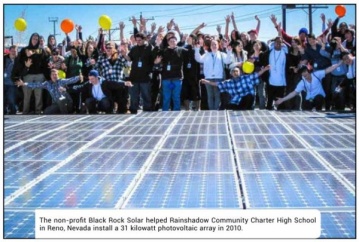
— Charles Hamilton, Warren, OH
Putting solar panels on your school is a great idea, not only to provide a free source of electricity, but also as a realworld way to teach students about the need for more renewable energy options and to make the school community part of the solution to our climate woes. School buildings are typically built with large, flat rooftops that are ideal candidates for solar installations.
According to the Foundation for Environmental Education’s Solar School Initiative, some 4,000 public and private school systems around the country have already installed solar panels at their own expense, or with funds raised through parent-teacher associations, student groups, individual donors and foundations. Analysts estimate that an additional 125,000 schools nationwide are good candidates for going solar and reaping the financial benefits of free energy.
Developing renewable alternatives is essential to our transition away from dirty fossil fuel sources.
Grant programs vary from state to state, though some can be very supportive of municipal solar projects. In Massachusetts, for example, cities qualified as “Green Communities” can apply for clean energy grants through a state-run program. California also has a number of solar-friendly programs that schools can capitalize on, including the School Facility Modernization Grants and Self-Generation Incentive program. Several other states offer similar programs.
There are also many federal grant opportunities, primarily from the U.S. Department of Energy (DOE). Their Loan Programs Office works with municipal and commercial applicants to help realize their energy goals. The Office of Energy Efficiency and Renewable Energy shares this mission, and recently made an investment of $19 million to improve our nation’s buildings, specifically naming hospitals and schools as top priorities.
There are also non-government options that can be utilized to bring solar to your local school district. The American Solar Energy Society (ASES) offers a wide array of resources for achieving successful solar school programs and for navigating issues around choosing a system. Their partnership with The Solar Foundation’s BDR Fund has set a goal of 20,000 solar systems installed at K-12 schools by the year 2020.
Another grant opportunity comes from the American Electric Power Foundation’s Learning from Light program, which has sponsored over 100 schools’ transitions to solar, starting with Bluffsview Elementary in Worthington, Ohio back in 1998. And the Walmart Foundation recently pledged to fund solar conversions at 20 schools in large cities around the country. A list of further programs offered by a number of organizations can be found at solarschools.org.
For more tips, check out the National Renewable Energy Laboratory’s report “Solar Schools Assessment and Implementation Project: Financing Options for Solar Installations on K-12 Schools,” which explains the myriad ways to finance and own solar installations at schools - including how to choose a location to maximize benefits.
CONTACTS: Solar School Initiative, www.solarschools.org; ASES, www.ases.org; DOE Loan Programs Office, energy.gov/lpo/loan-programsoffice; American Electric Power Foundation, www.aep.com; NREL, www.nrel.gov.























